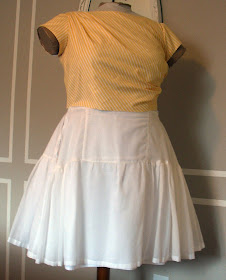I've mentioned before that I have a strong preference for fullness in skirts to be distributed more towards the sides and back, leaving the front flat. Besides finding it more flattering (who doesn't love a flatter tummy?) I actually find it more practical. As much as I love big swishy skirts, they can get in the way at times! By moving most of the fullness to the sides and back, it kind of pushes all that extra fabric behind me so it doesn't get in my way, but I still get to enjoy yards of fabric floating around me. :-)
I also find it to be extremely common in real vintage patterns and dresses. Here are just a few examples:
There's even one for a petticoat!
Since a lot of the purchased petticoats have fullness evenly distributed, I used this as inspiration and made my own. I wanted a comfy/non-scratchy version, though, and more for everyday dresses, so I went with a very light cotton lawn.
I didn't use a pattern to make this, just attached a circular top part to gathered rectangles, gathered where I wanted fullness, left it flat in front, added a few layers, and that was that. Pretty simple!
It's comfortable and works well for everyday wear when I'm feeling like I want a little extra fullness.
What's interesting to me is that I've noticed in some of the repro patterns, the original sketches had flat fronts but it isn't reflected in the pattern, like this one:
 |
| Butterick 6582 |
In this one the difference is very clear from the comparison of the sketches to the made-up version on the front:
Of course that's easy enough to remedy, but it's always interesting to me to see little changes like this and wonder why they were made!
In the meantime, I'll be rocking my flat fronted petticoat and dresses. :-)






















































